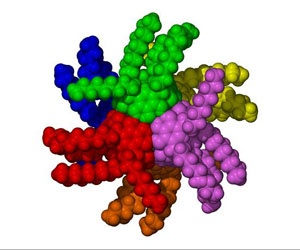Jul 16 2009
A new method for capturing significantly more heat from low-temperature geothermal resources holds promise for generating virtually pollution-free electrical energy. Scientists at the Department of Energy's Pacific Northwest National Laboratory will determine if their innovative approach can safely and economically extract and convert heat from vast untapped geothermal resources.
 PNNL's introduction of a metal-organic heat carrier, or MOHC, in the biphasic fluid may help improve thermodynamic efficiency of the heat recovery process. This image represents the molecular makeup of one of several MOHCs
PNNL's introduction of a metal-organic heat carrier, or MOHC, in the biphasic fluid may help improve thermodynamic efficiency of the heat recovery process. This image represents the molecular makeup of one of several MOHCs
The goal is to enable power generation from low-temperature geothermal resources at an economical cost. In addition to being a clean energy source without any greenhouse gas emissions, geothermal is also a steady and dependable source of power.
"By the end of the calendar year, we plan to have a functioning bench-top prototype generating electricity," predicts PNNL Laboratory Fellow Pete McGrail. "If successful, enhanced geothermal systems like this could become an important energy source." A technical and economic analysis conducted by the Massachusetts Institute of Technology estimates that enhanced geothermal systems could provide 10 percent of the nation's overall electrical generating capacity by 2050.
PNNL's conversion system will take advantage of the rapid expansion and contraction capabilities of a new liquid developed by PNNL researchers called biphasic fluid. When exposed to heat brought to the surface from water circulating in moderately hot, underground rock, the thermal-cycling of the biphasic fluid will power a turbine to generate electricity.
To aid in efficiency, scientists have added nanostructured metal-organic heat carriers, or MOHCs, which boost the power generation capacity to near that of a conventional steam cycle. McGrail cited PNNL's nanotechnology and molecular engineering expertise as an important factor in the development, noting that the advancement was an outgrowth of research already underway at the lab.
"Some novel research on nanomaterials used to capture carbon dioxide from burning fossil fuels actually led us to this discovery," said McGrail. "Scientific breakthroughs can come from some very unintuitive connections."
PNNL is receiving $1.2 million as one of 21 DOE Energy Efficiency and Renewable Energy grants through the Geothermal Technologies Program.
Some of the research was conducted in EMSL, DOE's Environmental Molecular Sciences Laboratory on the PNNL campus.
New Geothermal Heat Extraction Process To Deliver Clean Power Generation